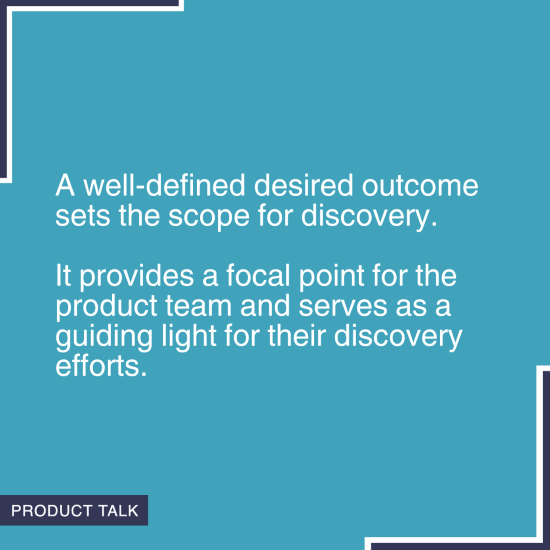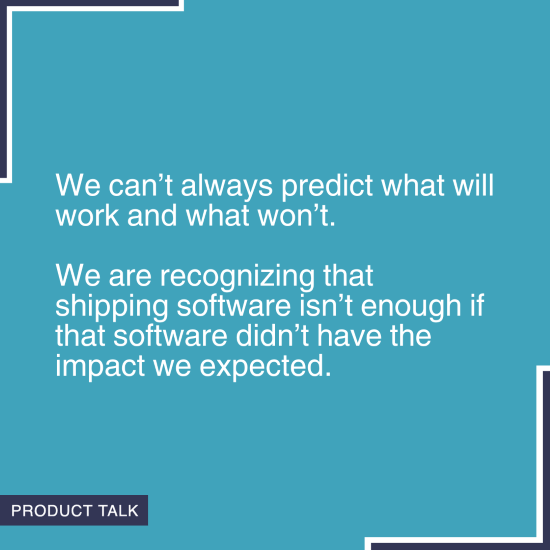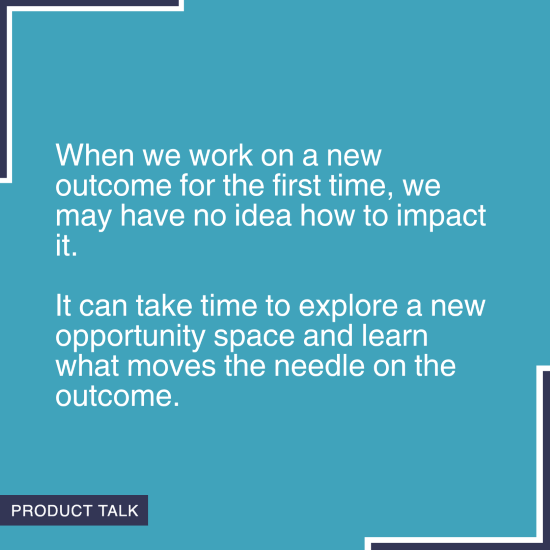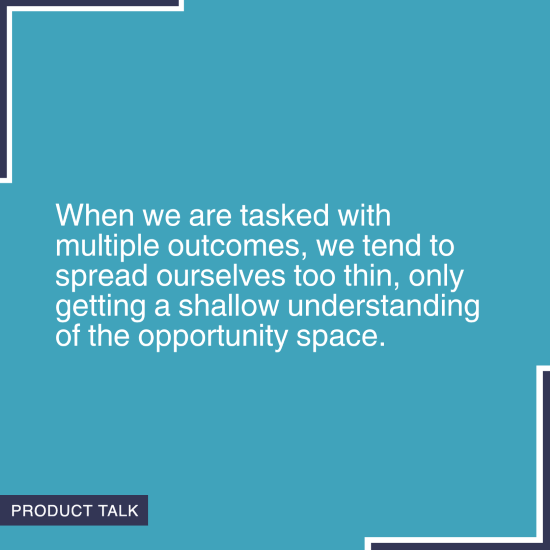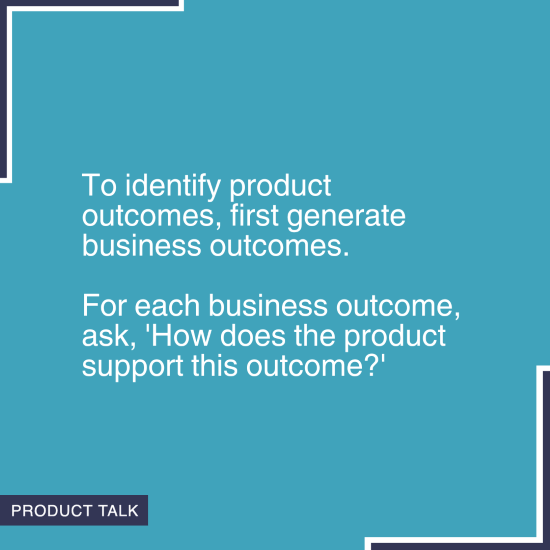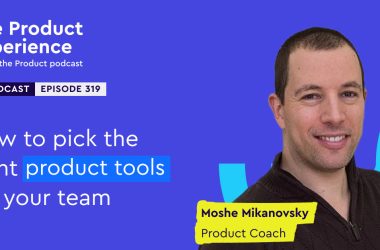A clear outcome sets the scope for discovery. It defines how much latitude a team has to explore. It sets a clear measure of success.
But many teams struggle to set the right outcome. Whether they have a hard time negotiating with stakeholders, feel pressure to commit to multiple outcomes, or unintentionally assign themselves an output instead, this is a critical aspect of continuous discovery where it’s all too easy to be led astray.
My goal with this article is to cover the most common questions we get about outcomes. Feel free to read from beginning to end or to skip ahead to the question(s) that you’re most curious about.
- What is a desired outcome?
- What’s the difference between an outcome and an output?
- Why are product teams shifting from focusing on outputs to focusing on outcomes?
- Who should be involved in defining a team’s outcome?
- Does an outcome need to be measurable?
- What’s the difference between a learning outcome and a performance outcome?
- How long should you spend on an outcome?
- How many outcomes can a team work on at once?
- What if multiple teams are being asked to deliver the same outcome?
- How and when does an outcome change over time?
- What are the different types of outcomes?
- How do you identify business outcomes?
- How do you identify product outcomes?
- How can product leaders hold teams accountable to outcomes?
- What’s the difference between outcomes and OKRs?
- How can you get started with outcomes?
What is a desired outcome?
A well-defined desired outcome sets the scope for discovery. It provides a focal point for the product team and serves as a guiding light for their discovery efforts.
A well-defined desired outcome sets the scope for discovery. It provides a focal point for the product team and serves as a guiding light for their discovery efforts. – Tweet This
But what exactly is a desired outcome? A desired outcome describes the expected impact we want our work to have on either customers or our business. It’s often a metric, something we want to measure. But it can also be directional, something that guides us while we figure out what to measure. For example, we might want to increase engagement, but not yet be sure how to measure engagement.
What’s the difference between an outcome and an output?
An output is something that you build or produce, while an outcome is the impact of that output on either customers or the business.
For example, Slack has a number of integrations. Integrations are outputs. Having integrations alone doesn’t create value. Customers using and finding value in these integrations are outcomes. If those customers find enough value that they retain their subscription for longer, that’s also an outcome.
| Output | Outcomes |
| Slack integrations |
|
Why are product teams shifting from focusing on outputs to focusing on outcomes?
We are starting to recognize the future is unpredictable. We can’t predict in January what we should build in March, let alone July or November. We can’t always predict what will work and what won’t. We are recognizing that shipping software isn’t enough if that software didn’t have the impact we expected.
We can’t always predict what will work and what won’t. We are recognizing that shipping software isn’t enough if that software didn’t have the impact we expected. – Tweet This
Returning to our Slack example, shipping more integrations doesn’t create value unless customers or users use and find value in those integrations.
When we task product teams with delivering outcomes, they aren’t done when the software ships. They are done when the software ships and has the expected impact.
For more on this shift, see:
Who should be involved in defining a team’s outcome?
Setting a team’s outcome should be the result of a two-way negotiation between the product leader (such as the Chief Product Officer or Vice President of Product) and the product trio.
The product leader brings the across-the-business view of the organization to the conversation and should communicate what’s most important to the business right now. But this does not mean the product leader is dictating solutions.
The product trio brings the customer and technology knowledge to the conversation as well as how much they believe they can move the metric in a given amount of time, usually a calendar quarter.
Does an outcome need to be measurable?
Oftentimes, an outcome is measurable—it’s a metric, something we can count. For example, increase the number of new customers or increase average order value.
But outcomes don’t always need to be measurable. Sometimes we know conceptually what our outcome should be, but we don’t have the ability to measure it yet. For example, Slack might want to measure the percentage of employees in a company who are onboarded into the workspace, but they might need to spend time collecting the total number of employees at all of their customers. While they collect this data, they may not be able to measure this outcome, but they can still work toward getting more employees onboarded.
What’s the difference between a learning outcome and a performance outcome?
When we work on a new outcome for the first time, we may have no idea how to impact it. It can take time to explore a new opportunity space and learn what moves the needle on the outcome.
When we work on a new outcome for the first time, we may have no idea how to impact it. It can take time to explore a new opportunity space and learn what moves the needle on the outcome. – Tweet This
When a team is working on a new outcome for the first time, I like to set a learning outcome—learn as much as you can about this opportunity space, rather than a performance outcome—have as much impact on this outcome as you can.
That doesn’t mean that a team tasked with a learning outcome won’t have an impact on the outcome. Rather, it gives them space to explore and dive deeper, rather than going after quick wins.
Sometimes we want or need quick wins. But sometimes we want a team to take the long view. Learning outcomes are great for when we want teams to take the long view.
How long should you spend on an outcome?
Many businesses have developed a fire-fighting culture where every customer complaint is treated like a crisis and product teams ping-pong from one outcome to the next, quarter after quarter.
But I don’t recommend working this way.
It takes time for us to learn how we can impact a new outcome, which means it’s more effective to stick with the same outcome from one quarter to the next. Ideally, a team will focus on the same outcome for at least two to three quarters. Some teams work on the same outcome for years.
This allows the team to build depth and true expertise in the opportunity space. This is when a team can have a big impact on an outcome.
How many outcomes can a team work on at once?
I recommend that product teams work on one outcome at a time.
Unfortunately, this is not the norm. Most companies think they can do much more than they actually can. As a result, they task teams with multiple outcomes.
We can’t, however, dive deep and truly understand multiple opportunity spaces at the same time. That means when we are tasked with multiple outcomes, we tend to spread ourselves too thin, only getting a shallow understanding of the opportunity space.
When we are tasked with multiple outcomes, we tend to spread ourselves too thin, only getting a shallow understanding of the opportunity space. – Tweet This
Instead, I suggest teams tasked with multiple outcomes do their own prioritization. Decide which outcome is the top priority and do good discovery there. Do what you can on the remainder outcomes, but recognize that you can’t go deep on multiple at once.
Generally, product trios can make the most impact when they only focus on a single outcome at a time.
What if multiple teams are being asked to deliver the same outcome?
Teams will feel more accountable, move faster, and thus have more impact, if they each focus on their own outcome. If you have multiple teams working on the same outcome, split the outcome so that each team has their own outcome.
There are a couple of ways to split outcomes:
- You can split the outcome by customer segment. For example, if you have multiple teams focused on engagement, you can split the outcome by having each team focused on different customers based on their tenure. For example, one team could focus on first-time users, whereas another team could focus on customers who are 3–12 months into using the product, and so on.
- You can split the outcome by customer journey step. For example, you could have one team focused on onboarding, another team focused on activation, and another team focused on retention.
As a general rule, set one unique outcome for each team.
How and when does an outcome change over time?
Generally, I want to see a team focused on the same directional outcome over time. It takes time to learn how to impact a metric and the longer a team spends on an outcome, the more impact they’ll have. If you do a good job of deriving your outcomes from your business model, they shouldn’t need to change that often.
This doesn’t, however, mean that the way that you measure an outcome will stay constant. For example, a team might spend a year focused on increasing engagement. When they first get started, they might start by measuring daily active users. As they learn more, they might evolve to measuring DAU/MAU (daily active users divided by monthly active users). And with more time, they might define and refine specific high-value activities that count as usage. As we learn more about what makes our customers successful, we should develop better ways of measuring that success.
To learn more, check out the following related articles:
- Insights from the CDH Benchmark Survey: How Are Teams Adopting Discovery Habits?
- Product in Practice: Iterating on Outcomes with Limited Data
- Product in Practice: Iterating to an Actionable Outcome at tails.com
What are the different types of outcomes?
In my book Continuous Discovery Habits, I outlined three different types of measurements that product teams tend to use: business outcomes, product outcomes, and traction metrics.
A business outcome measures the health of the business. It’s typically a financial metric that is derived from the product’s revenue model. For example, a subscription service might have the following business outcomes: increase # of new customers, increase average monthly spend, and increase retention.
A product outcome typically measures a customer behavior in the product or a customer sentiment about the product.
Business outcomes tend to be lagging indicators. We only know if we increase monthly spend after a customer makes a purchase decision. Product outcomes, on the other hand, should be leading indicators of lagging business outcomes. For example, engagement is a common product outcome, because for most companies, engagement is a good predictor of retention.
When defining product outcomes, however, we can get too narrow with our scope. We don’t want to use a traction metric as our discovery outcome. A traction metric measures adoption of a single feature. The challenge with setting traction metrics as our discovery outcomes is they often encourage the wrong behavior. For example, we don’t want to task a team to increase the number of searches. Plenty of customers might be perfectly satisfied with a product without ever conducting a search. Even if they do use the search tool, more searches are rarely better, as they usually indicate the customer is having trouble finding what they are looking for.
How do you identify business outcomes?
Business outcomes are typically derived from a product’s revenue model. We can identify business outcomes by asking, “If you were to generate a formula to calculate revenue, what variables would it include?”
For a subscription business, this might be: # of customers x average monthly spend x average subscription length
For an eCommerce business, this might be: # of customers x average order size x # of purchases
Each of these variables also have their own inputs which can help you identify additional business outcomes. For a SaaS business, inputs to # of customers might be: web traffic x conversion rate.
For more on this topic, see:
How do you identify product outcomes?
Product outcomes represent customer behaviors within the product or customer sentiment about the product. They should be leading indicators of business outcomes.
To identify product outcomes, first generate business outcomes. For each business outcome, ask, “How does the product support this outcome?”
To identify product outcomes, first generate business outcomes. For each business outcome, ask, ‘How does the product support this outcome?’ – Tweet This
For example, the product might support customer acquisition by driving SEO traffic.
For more on this topic, see:
How can product leaders hold teams accountable to outcomes?
It can be hard for both product leaders and product teams to successfully make the shift from outputs to outcomes. One of the most common questions I get is, “How do I know if my teams are making enough progress toward their outcome?”
When we ask our teams to deliver outputs, it’s easy to see if they are performing. We can clearly evaluate if they delivered the outputs. Understanding if a team is making progress on their outcome can be trickier.
Teams rarely make linear progress on their outcomes. There can be a lot of starts and stops. Sometimes a team might get lucky and find something that has a big impact quickly, but more often than not, it takes a lot of trial and error.
Given this uncertainty, I like to monitor progress by keeping an eye on key activities like interviewing and assumption testing, checking in regularly to see what they are learning, as well as monitoring progress on the outcome itself.
For more on this topic, see:
- Everyone Thinks They Are Managing by Outcomes. Here’s How to Actually Do It.
- Managing Product Teams for Success
- Building a Culture of Accountability for Empowered Product Teams
What’s the difference between outcomes and OKRs?
An OKR is comprised of an objective and a set of key results. The objective is a qualitative statement that should inspire you and/or your team. The key results are quantitative measures that might indicate you’ve reached that objective.
An outcome is the result of some actions. In the product world, we tend to think of outcomes as the impact of what we build. So we are building output X because we think it will result in outcome Y.
We can use the OKR format to express an outcome both qualitatively (with the objective) and quantitatively (with the key results). We can express business outcomes or product outcomes as OKRs.
The real work is figuring out which outcomes matter. Once you’ve done that, you can represent any outcome as an OKR if that’s your preferred format.
To learn more about this topic, check out this article:
How can you get started with outcomes?
The easiest way to get started with outcomes is to think through what outcomes might matter most to your business. A good place to start is with your product’s revenue model as described in “How do you identify business outcomes?”
From there, you can deconstruct your business outcomes, by asking, “What inputs help drive this metric?”
Once you’ve enumerated your business outcomes, you can ask, “How do customer behaviors in the product or customer sentiment about the product impact each of these business outcomes?” This question helps you enumerate product outcomes. See: “How do you identify product outcomes?”
Once you have a good understanding of the outcomes your company cares about, you can now evaluate each item in your backlog and ask, “How might each of these contribute to our outcomes?” The more you can connect the dots between what you are building and the outcomes your company cares about, the more likely you’ll have a bigger impact.
If you need help with defining business and outcomes and product outcomes, we cover both in our Master Class and in our Defining Outcomes course. If you also want help choosing the right outcome to focus on right now, we dive deep on that in our Defining Outcomes course.
The post Shifting from Outputs to Outcomes: Why It Matters and How to Get Started appeared first on Product Talk.
Shifting from Outputs to Outcomes: Why It Matters and How to Get Started was first posted on July 17, 2024 at 6:00 am.
©2022 “Product Talk“. Use of this feed is for personal non-commercial use only. If you are not reading this article in your feed reader, then the site is guilty of copyright infringement. Please let us know at support@producttalk.org.

